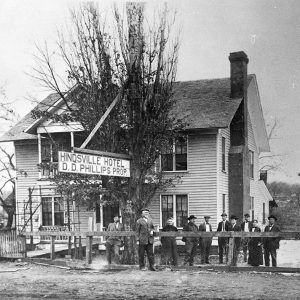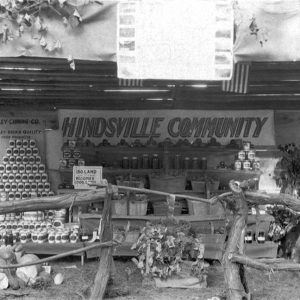calsfoundation@cals.org
Hindsville (Madison County)
| Latitude and Longitude: | 36°08’39″N 093°51’44″W |
| Elevation: | 1,368 feet |
| Area: | 0.37 square miles (2020 Census) |
| Population: | 90 (2020 Census) |
| Incorporation Date: | January 9, 1964 |
Historical Population as per the U.S. Census:
|
1810 |
1820 |
1830 |
1840 |
1850 |
1860 |
1870 |
1880 |
1890 |
1900 |
|
– |
– |
– |
– |
– |
– |
– |
– |
– |
– |
|
1910 |
1920 |
1930 |
1940 |
1950 |
1960 |
1970 |
1980 |
1990 |
2000 |
|
– |
– |
– |
– |
– |
– |
– |
– |
69 |
75 |
|
2010 |
2020 |
|
|
|
|
|
|
|
|
|
61 |
90 |
|
|
|
|
|
|
|
|
The town of Hindsville is near U.S. Highway 412 in western Madison County. Hindsville was established in Vaughan Valley, one of the few areas in the Ozark Mountains that consists of large flat acres suitable for farming.
Osage hunted and fished in the Ozark Mountains until after the Louisiana Purchase made Arkansas part of the United States in 1803. Settlers first began arriving in Vaughan Valley in the 1830s. John Hinds, for whom the town would be named, built the first house in the valley in 1832. His brother William Hinds arrived in 1832, as did brothers David and Samuel Vaughan, along with Andrew Smith (who is thought to have married Abigail Hinds, a sister of the Hinds brothers). A Baptist congregation began meeting in the 1830s, and it became firmly established in 1846, using the name Mount Zion.
Opinions about slavery in the valley were divided, as the Vaughans owned slaves but many of their neighbors did not. No Civil War battles were fought in the area, but bushwhackers were very active. One group of bushwhackers captured, tortured, and killed David Vaughan during the war, trying to make him divulge the location of his money. Similar disorder continued after the war. During the war, residents chose a hilltop location southwest of town to grow vegetables to feed the community; while individual farms continued to be raided for some years, the hilltop vegetable patch remained undisturbed. To this day, the hill is known as Tater Hill.
Samuel West Peel and F. G. Berry opened the first store in Hindsville in 1868; the same year, a post office was established at their store. Peel, a practicing attorney, soon left for Bentonville (Benton County), but Berry continued to operate the store. A steam mill was built in 1875.
The next year, after the Baptist congregation had struggled to regroup following the war, the Baptists proposed a community church that would be served by various ministers, including Presbyterians and Methodists as well as Baptists. The church was established, but the Baptists withdrew from the congregation in 1881 and re-formed their own congregation.
A school district was established for Hindsville in 1877, and 134 students were enrolled in 1878. A poor farm was established near Hindsville in 1890 and continued to operate into the Depression.
An 1895 fire destroyed two stores, but the community continued to grow. Around 1900, Hindsville had two drugstores, a doctor’s office, a livery stable, a blacksmith shop, a saloon, a hotel, and several general stores. The Valley Bank of Hindsville opened in 1915. Around 1925, lots were surveyed to expand Hindsville, but nothing was ever built on the surveyed lots.
In 1925, a school was built with the help of the Presbyterians in the community church. This school burned down in December 1937, but a new school was built over the next two years under the auspices of the Works Progress Administration (WPA). By this time, the school had become a public school and the Presbyterians had taken over operation of the community church.
During the 1920s, Arkansas Highway 68 was built through Hindsville to Huntsville (Madison County); it was later extended to Alpena (Boone and Carroll counties). Hindsville incorporated in 1964.
In 1982, the road became U.S. Highway 412. After that re-designation, a new route was surveyed and built for the highway, bypassing Hindsville, but the older highway continues to operate as Business Highway 412. Hindsville schools became part of the consolidated Huntsville School District, although the school building in Hindsville continued to be used into the 1970s.
In 2015, Hindsville had several businesses both within the community and nearby on Highway 412. These businesses include a craft store and a butcher shop both named for the nearby War Eagle Fair (now the Ozark Arts and Crafts Fair).
Hindsville resident Ashton Campbell was named Miss Arkansas in June 2014.
For additional information:
Russell, Joy, and Christy Russell. History of Hindsville, Arkansas: The Town, the Area, and the People. Huntsville, AR: Madison County Genealogical and Historical Society, 2001.
Steven Teske
Butler Center for Arkansas Studies
 Hindsville Hotel
Hindsville Hotel  Hindsville Buildings
Hindsville Buildings  Madison County Map
Madison County Map  Valley Canning Company
Valley Canning Company 



Comments
No comments on this entry yet.